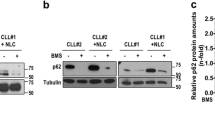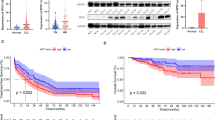Abstract
Despite significant therapeutic improvements chronic lymphocytic leukemia (CLL) remains an incurable disease and there is a persistent pursuit of new treatment alternatives. Lurbinectedin, a selective inhibitor of active transcription of protein-coding genes, is currently in phase II/III clinical trials for solid tumors such as small-cell lung cancer (SCLC). In this study, we aimed to evaluate the activity of Lurbinectedin on circulating mononuclear cells from CLL patients and to determine whether Lurbinectedin could affect the cross-talk between B-CLL cells and the tumor microenvironment. We found that Lurbinectedin induced a dose- and time-dependent death in all cell types evaluated, with B cells, monocytes and monocytic myeloid derived suppressor cells (Mo-MDSC) being the most susceptible populations. At sub-apoptotic doses, Lurbinectedin decreased the expression of CCR7 in B-CLL cells and impaired their migration towards CCL19 and CCL21. Furthermore, low concentrations of Lurbinectedin stimulated the synthesis of pro-IL1β in monocytes and nurse-like cells, without inducing the inflammasome activation. Altogether, these results indicate that Lurbinectedin might have antitumor activity in CLL due to its direct action on leukemic cells in combination with its effects on the tumor microenvironment. Our findings encourage further investigation of Lurbinectedin as a potential therapy for CLL.





Similar content being viewed by others
Abbreviations
- CLL:
-
Chronic lymphocytic leukemia
- HD:
-
Healthy donor
- Mo-MDSC:
-
Monocytic myeloid-derived suppressor cells
- NLC:
-
Nurse-like cells
- P-Erk½:
-
Phosphorylated extracellular signal-regulated kinase 1/2
- SCLC:
-
Small-cell lung cancer
- TAM:
-
Tumor-associated macrophages
References
Chiorazzi N, Rai KR, Ferrarini M (2005) Chronic lymphocytic leukemia. N Engl J Med 352:804–815. https://doi.org/10.1056/NEJMra041720
Dighiero G, Hamblin TJ (2008) Chronic lymphocytic leukaemia. Lancet (London, England) 371:1017–1029. https://doi.org/10.1016/S0140-6736(08)60456-0
Cramer P, Langerbeins P, Eichhorst B, Hallek M (2016) Advances in first-line treatment of chronic lymphocytic leukemia: current recommendations on management and first-line treatment by the German CLL Study Group (GCLLSG). Eur J Haematol 96:9–18. https://doi.org/10.1111/ejh.12678
Ghia P, Circosta P, Scielzo C et al (2005) Differential effects on CLL cell survival exerted by different microenvironmental elements. Curr Top Microbiol Immunol 294:135–145
Caligaris-Cappio F, Bertilaccio MTS, Scielzo C (2014) How the microenvironment wires the natural history of chronic lymphocytic leukemia. Semin Cancer Biol 24:43–48. https://doi.org/10.1016/j.semcancer.2013.06.010
Kurtova AV, Balakrishnan K, Chen R et al (2009) Diverse marrow stromal cells protect CLL cells from spontaneous and drug-induced apoptosis: development of a reliable and reproducible system to assess stromal cell adhesion-mediated drug resistance. Blood 114:4441–4450. https://doi.org/10.1182/blood-2009-07-233718
Burger JA, Tsukada N, Burger M et al (2000) Blood-derived nurse-like cells protect chronic lymphocytic leukemia B cells from spontaneous apoptosis through stromal cell-derived factor-1. Blood 96:2655–2663. https://doi.org/10.1182/blood.V96.8.2655
Caligaris-Cappio F (2003) Role of the microenvironment in chronic lymphocytic leukaemia. Br J Haematol 123:380–388
Redondo-Muñoz J, García-Pardo A, Teixidó J (2019) Molecular players in hematologic tumor cell trafficking. Front Immunol. https://doi.org/10.3389/fimmu.2019.00156
de Rooij MFM, Kuil A, Geest CR et al (2012) The clinically active BTK inhibitor PCI-32765 targets B-cell receptor- and chemokine-controlled adhesion and migration in chronic lymphocytic leukemia. Blood 119:2590–2594. https://doi.org/10.1182/blood-2011-11-390989
Leal JFM, Martínez-Díez M, García-Hernández V et al (2010) PM01183, a new DNA minor groove covalent binder with potent in vitro and in vivo anti-tumour activity. Br J Pharmacol 161:1099–1110. https://doi.org/10.1111/j.1476-5381.2010.00945.x
Santamaría Nuñez G, Robles CMG, Giraudon C et al (2016) Lurbinectedin specifically triggers the degradation of phosphorylated RNA polymerase II and the formation of DNA breaks in cancer cells. Mol Cancer Ther 15:1–14. https://doi.org/10.1158/1535-7163.MCT-16-0172
Huang P, Plunkett W (1991) Action of 9-beta-d-arabinofuranosyl-2-fluoroadenine on RNA metabolism. Mol Pharmacol 39:449–455
Huang P, Sandoval A, Van Den Neste E et al (2000) Inhibition of RNA transcription: a biochemical mechanism of action against chronic lymphocytic leukemia cells by fludarabine. Leukemia 14:1405–1413
Belgiovine C, Bello E, Liguori M et al (2017) Lurbinectedin reduces tumour-associated macrophages and the inflammatory tumour microenvironment in preclinical models. Br J Cancer 117:628–638. https://doi.org/10.1038/bjc.2017.205
Kuroda H, Mabuchi S, Kozasa K et al (2017) PM01183 inhibits myeloid-derived suppressor cells in vitro and in vivo. Immunotherapy 9:805–817. https://doi.org/10.2217/imt-2017-0046
Risnik D, Podaza E, Almejún MB et al (2017) Revisiting the role of interleukin-8 in chronic lymphocytic leukemia. Sci Rep 7:15714. https://doi.org/10.1038/s41598-017-15953-x
Berhanu D, Mortari F, De Rosa SC, Roederer M (2003) Optimized lymphocyte isolation methods for analysis of chemokine receptor expression. J Immunol Methods 279:199–207
Colado A, Almejún MB, Podaza E et al (2017) The kinase inhibitors R406 and GS-9973 impair T cell functions and macrophage-mediated anti-tumor activity of rituximab in chronic lymphocytic leukemia patients. Cancer Immunol Immunother 66:461–473. https://doi.org/10.1007/s00262-016-1946-y
Niemann CU, Herman SEM, Maric I et al (2016) Disruption of in vivo chronic lymphocytic leukemia tumor-microenvironment interactions by ibrutinib—findings from an investigator-initiated phase II study. Clin Cancer Res 22:1572–1582. https://doi.org/10.1158/1078-0432.CCR-15-1965
Podaza E, Risnik D, Colado A et al (2019) Chronic lymphocytic leukemia cells increase neutrophils survival and promote their differentiation into CD16 high CD62L dim immunosuppressive subset. Int J Cancer 144:1128–1134. https://doi.org/10.1002/ijc.31762
Elez ME, Tabernero J, Geary D et al (2014) First-in-human phase I study of Lurbinectedin (PM01183) in patients with advanced solid tumors. Clin Cancer Res 20:2205–2214. https://doi.org/10.1158/1078-0432.CCR-13-1880
Fernandez-Teruel C, Gonzalez I, Trocóniz IF et al (2019) Population-pharmacokinetic and covariate analysis of Lurbinectedin (PM01183), a new RNA polymerase II inhibitor, in pooled phase I/II trials in patients with cancer. Clin Pharmacokinet 58:363–374. https://doi.org/10.1007/s40262-018-0701-2
Liu J, Zhou Y, Huang Q, Qiu L (2015) CD14+HLA-DRlow/- expression: a novel prognostic factor in chronic lymphocytic leukemia. Oncol Lett 9:1167–1172. https://doi.org/10.3892/ol.2014.2808
Jitschin R, Braun M, Büttner M et al (2014) CLL-cells induce IDOhi CD14+HLA-DRlo myeloid-derived suppressor cells that inhibit T-cell responses and promote TRegs. Blood 124:750–760. https://doi.org/10.1182/blood-2013-12-546416
Patten PEM, Buggins AGS, Richards J et al (2008) CD38 expression in chronic lymphocytic leukemia is regulated by the tumor microenvironment. Blood 111:5173–5181. https://doi.org/10.1182/blood-2007-08-108605
Burger JA, Gribben JG (2014) The microenvironment in chronic lymphocytic leukemia (CLL) and other B cell malignancies: insight into disease biology and new targeted therapies. Semin Cancer Biol 24:71–81. https://doi.org/10.1016/j.semcancer.2013.08.011
Elías EE, Almejún MB, Colado A et al (2018) Autologous T-cell activation fosters ABT-199 resistance in chronic lymphocytic leukemia: rationale for a combined therapy with SYK inhibitors and anti-CD20 monoclonal antibodies. Haematologica 103:e458–e461. https://doi.org/10.3324/HAEMATOL.2018.188680
Till KJ, Lin K, Zuzel M, Cawley JC (2002) The chemokine receptor CCR7 and alpha4 integrin are important for migration of chronic lymphocytic leukemia cells into lymph nodes. Blood 99:2977–2984
Lopez-Giral S, Quintana NE, Cabrerizo M et al (2004) Chemokine receptors that mediate B cell homing to secondary lymphoid tissues are highly expressed in B cell chronic lymphocytic leukemia and non-Hodgkin lymphomas with widespread nodular dissemination. J Leukoc Biol 76:462–471. https://doi.org/10.1189/jlb.1203652.1
Ghiringhelli F, Bruchard M, Apetoh L (2013) Immune effects of 5-fluorouracil: ambivalence matters. Oncoimmunology 2:e23139
Shurin MR (2013) Dual role of immunomodulation by anticancer chemotherapy. Nat Med 19:20–22. https://doi.org/10.1038/nm.3045
Franchi L, Eigenbrod T, Muñoz-Planillo R, Nuñez G (2009) The inflammasome: a caspase-1-activation platform that regulates immune responses and disease pathogenesis. Nat Immunol 10:241–247. https://doi.org/10.1038/ni.1703
Yan X-J, Dozmorov I, Li W et al (2011) Identification of outcome-correlated cytokine clusters in chronic lymphocytic leukemia. Blood 118:5201–5210. https://doi.org/10.1182/blood-2011-03-342436
Netea MG, Nold-Petry CA, Nold MF et al (2009) Differential requirement for the activation of the inflammasome for processing and release of IL-1beta in monocytes and macrophages. Blood 113:2324–2335. https://doi.org/10.1182/blood-2008-03-146720
Podaza E, Sabbione F, Risnik D et al (2017) Neutrophils from chronic lymphocytic leukemia patients exhibit an increased capacity to release extracellular traps (NETs). Cancer Immunol Immunother. https://doi.org/10.1007/s00262-016-1921-7
Herishanu Y, Kay S, Sarid N et al (2013) Absolute monocyte count trichotomizes chronic lymphocytic leukemia into high risk patients with immune dysregulation, disease progression and poor survival. Leuk Res 37:1222–1228. https://doi.org/10.1016/j.leukres.2013.07.017
Friedman DR, Sibley AB, Owzar K et al (2016) Relationship of blood monocytes with chronic lymphocytic leukemia aggressiveness and outcomes: a multi-institutional study. Am J Hematol 91:687–691. https://doi.org/10.1002/ajh.24376
Nishio M, Endo T, Tsukada N et al (2005) Nurselike cells express BAFF and APRIL, which can promote survival of chronic lymphocytic leukemia cells via a paracrine pathway distinct from that of SDF-1alpha. Blood 106:1012–1020. https://doi.org/10.1182/blood-2004-03-0889
Lohmann G, Vasyutina E, Bloehdorn J et al (2017) Targeting transcription-coupled nucleotide excision repair overcomes resistance in chronic lymphocytic leukemia. Leukemia 31:1177–1186. https://doi.org/10.1038/leu.2016.294
Hulkkonen J, Vilpo J, Vilpo L et al (2000) Interleukin-1 beta, interleukin-1 receptor antagonist and interleukin-6 plasma levels and cytokine gene polymorphisms in chronic lymphocytic leukemia: correlation with prognostic parameters. Haematologica 85:600–606
Acosta-Rodriguez EV, Napolitani G, Lanzavecchia A, Sallusto F (2007) Interleukins 1beta and 6 but not transforming growth factor-beta are essential for the differentiation of interleukin 17-producing human T helper cells. Nat Immunol 8:942–949. https://doi.org/10.1038/ni1496
Pang N, Zhang R, Li J et al (2016) Increased IL-10/IL-17 ratio is aggravated along with the prognosis of patients with chronic lymphocytic leukemia. Int Immunopharmacol 40:57–64. https://doi.org/10.1016/j.intimp.2016.07.008
Jain P, Javdan M, Feger FK et al (2012) Th17 and non-Th17 interleukin-17-expressing cells in chronic lymphocytic leukemia: delineation, distribution, and clinical relevance. Haematologica 97:599–607. https://doi.org/10.3324/haematol.2011.047316
Acknowledgements
The authors want to specially thank the patients and healthy donors who provided blood samples for this research. Also, we are indebted to Beatriz Loria, María Tejeda, Romina Pagano and Federico Fuentes for their technical assistance.
Funding
This work was supported by a Grant from FONCyT (PICT 212/2012), Ministry of Science, Technology and Innovation, Argentina.
Author information
Authors and Affiliations
Contributions
DR and MG designed the study. DR, AC, EP, MBA, NS and EEE performed the experiments. RFB and HF-G recruited patients and performed clinical analysis. DR, MB, PO, RG and MG analyzed the data. DR, AC and MG wrote the manuscript. All authors reviewed and approved the manuscript.
Corresponding author
Ethics declarations
Conflict of interest
The authors declare that they have no conflict of interest.
Ethical approval
This research was conducted in accordance with the Helsinki Declaration. The study was approved on September 11th of 2012 and revalidated on April 11th of 2018 by the Institutional Review Board of the National Academy of Medicine, Buenos Aires, Argentina.
Informed consent
Peripheral blood samples were collected from CLL patients and healthy donors after written informed consent allowing the use of their specimens and data for research and for publication.
Additional information
Publisher's Note
Springer Nature remains neutral with regard to jurisdictional claims in published maps and institutional affiliations.
Electronic supplementary material
Below is the link to the electronic supplementary material.
Rights and permissions
About this article
Cite this article
Risnik, D., Colado, A., Podaza, E. et al. Immunoregulatory effects of Lurbinectedin in chronic lymphocytic leukemia. Cancer Immunol Immunother 69, 813–824 (2020). https://doi.org/10.1007/s00262-020-02513-y
Received:
Accepted:
Published:
Issue Date:
DOI: https://doi.org/10.1007/s00262-020-02513-y




